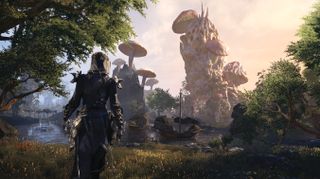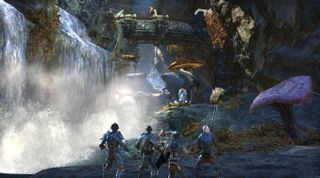A valiant return to Morrowind in The Elder Scrolls Online
Revisiting one of PC's greatest RPG settings for the first time.

This article was originally published in PC Gamer issue 302. For more quality articles about all things PC gaming, you can subscribe now in the UK and the US.
The MMO genre is a hard one to review. A game launches, then we have to score it even as it shifts in shape and quality before our eyes. The Elder Scrolls Online had an especially tough start, as servers melted, quests bugged out and those initial weeks dragged into a merciless grind. And yet in the time since its arrival on my PC, a new justice system, vast story DLC packs and the abolition of level restrictions on exploration have changed ESO more than any other MMO I can recall. The next step will take us even deeper into gold-plated nostalgia territory.
I know it’s going to work the first time I set eyes on ESO’s spanking new Seyda Neen. The opening section of the now 15-year-old Elder Scrolls III returns as a starting zone for the sizeable new landmass of Vvardenfell. The team at Zenimax took the height map of the 2001 original and placed it directly in the existing mass of ESO’s Tamriel. Gorgeously detailed, it’s also hearteningly familiar, complete with NPC ancestors of memorable characters to chat with.
Rather than a straight rehash, this Vvardenfell is set 700 years prior to the events of TESIII, so while there are homages by the dozen, there’s also a ton of new things to discover. Vivec City has only three cantons, the rest still under construction and explorable in their varying dredged-out states. The volcano at the centre of the island isn’t nearly as catastrophically encompassing of its surroundings. Get close and there’s ash galore, but also lush mushroom-bedecked forests and coastal regions as yet unmolested by the choking air. ZeniMax has worked closely with parent publisher Bethesda in its bid to tickle our nostalgia glands.

I get the sense that ZeniMax finally knows what its take on the MMO genre is.
"This is Bethesda’s baby, right?" creative director Rich Lambert tells me. "TESIII is the thing that put them on the map. So we’ve had to work really closely with them to make sure that the things we’re doing and the stories we’re telling do TESIII justice, and work with what Bethesda originally envisioned."
Lambert is quick to emphasise that this is not an ‘expansion’ in the traditional sense. ZeniMax sees ESO: Morrowind as a fresh standalone entry point into its world, true to its One Tamriel philosophy that all content should be available to all players at all times.
Equally, Lambert doesn’t want new players who climbed aboard the Elder Scrolls ship via Skyrim or Oblivion to feel left out. "The story we’ve written and the content we’ve got stands on its own," he says. "It’s not just nostalgia. It’s a really strong story and the writers have gone to painstaking detail. Even if you don’t know any of the history you’re gonna get a bit of a lesson."
The biggest gaming news, reviews and hardware deals
Keep up to date with the most important stories and the best deals, as picked by the PC Gamer team.
Perhaps this is where the true allure of a return to Morrowind lies. It’s hard, in the sharp contemporary gaming landscape of 2017, to make those who weren’t there understand just how formative TESIII was. The past 15 years have not been kind to it. While a full-blown official remake is almost certainly off the cards, ESO seems like the perfect place for new players to discover Vvardenfell without stabbing themselves in the retinas with the jagged edges of the ancient Bethesda game engine.

Whether you’re new or not, there’s a whole lot of game tucked away inside the Morrowind ‘chapter’. On top of the new map, which is the biggest single landmass ZeniMax has ever built, 30 percent bigger than Orsinium, there’s a new class, a new 12-person Trial, two new dungeons, and an all-new set of PvP modes and maps: Battlegrounds.
The Warden fills out a slot much sought-after in ESO’s preexisting range of classes, offering a druidic array of skill sets. You can opt to plough points into three new skill paths as you progress. Choose Green Balance skills and you’ll earn a bunch of healing abilities, from actively aimed frontal cone bursts of heal-over-time buffs to a full area-of-effect ultimate skill that causes ethereal blue flora to burst from the ground around you and your allies. Over in the Winter’s Embrace skill tree are the class’s tankier moves, letting you summon icy armour and control the battlefield with snares that whip enemies around. The showstopper is the Animal Companion skill set. Here you’ll find abilities that summon an array of spirit-form pets to deal out DPS. Most, like the infamous Cliff Racers, themed around Morrowind itself.
Your ultimate ability on this path summons a permanent bear to tank damage for you. In the development build I was shown there were no pet control commands, but I’m told these are being worked on for the final game.For someone returning to the game after that initial rocky launch period, the Warden is a prime example of how many small changes have been implemented, how many small design decisions have been reached, over the last two years. The mantra that any class can wear any armour, for example, initially made player avatars hard to read at a glance. Is that a knight barrelling towards me over the hillocks of Cyrodiil, or is it a sorcerer with delusions of grandeur? Too many other games manage to avoid this readability problem for me not to whinge about it here.

For those with fond memories of the original, the allure of ESO’s Morrowind lies in that PvE experience.
The Warden is so very clear to read. Each of its abilities leaves a glowing blue aura around the character model. Whether it’s huge butterfly wings, icy steam emerging from his dual daggers, or spiny tendrils poking out of his back, so many little touches have been added to the skills’ animations and colour schemes in order to make this dream of all weapons/all armour/all classes actually work and still be clear amid even the most chaotic of player masses.I’m also shown the new PvE dungeon Trial. Its Clockwork City setting will be familiar as a concept to TESIII veterans, being the globular mini-Nirn rebuilt by one of Vvardenfell’s Tribunals inside a tiny orb. The new Trial takes us inside this tiny city, complete with alien half-metal half-flesh monsters, an unnerving cog-filled skybox and a lush interlocking verticality that brings Dark Souls’ woven level design to mind.
Those aforementioned PvP Battlegrounds complete the package, with additional plans for three new maps upon which to battle with buds. These smaller scale arenas offer the kind of elf-on-orc action that’s currently missing in the all-out warfare of ESO’s Cyrodiil PvP area. Here combat is limited to a more manageable 4 vs 4 vs 4 affair. Team Deathmatches and Capture The Flag (or Capture The Scroll) are two modes I’ve seen in action. Rather than featureless bowls for teams to duel it out across, each arena feels like it has been built to enable each class to thrive tactically. Daedric ruins feature plenty of line-of-sight blockers to help sneakier types get the drop on their foes, while a verdant Dwemer fort map has towers with better views of its surroundings for those with long-range skills to fight over.
For those with fond memories of the original, the allure of ESO’s Morrowind lies in that PvE experience. Since launch this MMO has reinvigorated its base game with the sense of discovery and exploration that the series’ singleplayer efforts have thrived on. In ESO: Morrowind, I get the sense that ZeniMax finally knows what its take on the MMO genre is, and that it has found the perfect setting with which to demonstrate that to those who bounced off the game the first time around.
Most Popular

